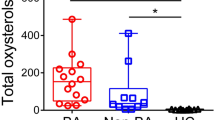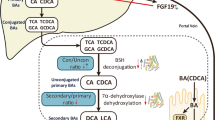Abstract
This study evaluated the efficacy of measuring urinary sulfated bile acids (USBA) for diagnosis of bacterial cholangitis in patients with biliary atresia. Eight infants with biliary atresia were recruited. The USBA level was measured when they were admitted to hospital with a fever of unknown origin. Clinical manifestations and laboratory data were reviewed. The standard USBA value for each patient (S-USBA) was defined as the level measured when they had no fever, and USBA ratio (R-USBA) was calculated as the USBA level during the febrile episode divided by the S-USBA. Then R-USBA values were compared between febrile episodes with and without cholangitis to assess the diagnostic ability of USBA. Twenty-three febrile episodes occurred in eight patients during a 15-month period. Nine episodes were diagnosed as being due to cholangitis, five were due to non-cholangitis, and nine were of undetermined origin. The R-USBA value ranged from 1.5 to 15.4 during cholangitis episodes and from 0.4 to 1.2 during non-cholangitis febrile episodes. When fever was of undetermined origin, R-USBA was found to be increased during some episodes and not in others. USBA increased immediately in patients with cholangitis. The measurement of USBA is a useful non-invasive test for cholangitis in patients with biliary atresia who had undergone Kasai’s operation.
Similar content being viewed by others
References
Makino I, Hashimoto H, Shinozaki K, Yoshino K, Nakagawa S (1975) Sulfated and nonsulfated bile acids in urine, serum, and bile of patients with hepatobiliary disease. Gastroenterol 68:545–553
Obatake M, Muraji T, Satoh S, Nishijima E, Tsugawa C (2002) Urinary sulfated bile acids: a new simple urine test for cholestasis in infants and children. J Pediatr Surg 37:1707–1708
Muraji T, Harada T, Miki K, Moriuchi T, Obatake M, Tsugawa C (2003) Urinary sulfated bile acid concentrations in infants with biliary atreisa and breast-feeding jaundice. Pediatr Int 45:281–283
Japanese Biliary Atresia Society (2000) Nationwide Registry of Biliary Atresia, 1998. Jap J Pediatr Surg 36:348–353
Ernest Van Heurn LW, Saing H, Tam PKH (2003) Cholangitis after hepatic portoenterostomy for biliary atresia: a multivariate analysis of risk factors. J Pediatr 142:566–571
Wu ET, Chen HL, Ni YH, Lee PI, Hsu HY, Lai HS, Chang MH (2001) Bacterial cholangitis in patients with biliary atresia: impact on short-term outcome. Pediatr Surg Int 17:390–395
Bu LN, Chen HL, Chang CJ, Ni YH, Hsu HY, Lai HS, Hsu WM, Chang MH (2003) Prohylactic oral antibiotics in prevention of recurrent cholangitis after the Kasai portoenterostomy. J Pediatr Surg 38:590–593
Rothenberg SS, Schroter GPJ, Karrer FM, Lilly JR (1989) Cholangitis after the Kasai operation for biliary atresia. J Pediatr Surg 24:729–732
Gottrand F, Bernard O, Hadchouel M, Pariente D, Gauthier F, Alagille D (1991) Late cholangitis after successful surgical repair of biliary atresia. Am J Dis Child 145:213–215
Ecoffey C, Rothman E, Bernard O, Hadchouel M, Valayer J, Alagille D (1987) Bacterial cholangitis after surgery for biliary atresia. J Pediatr 111:824–829
Tagge DU, Tagge EP, Drongowski RA, Oldham KT, Coran AG (1991) A long-term experience with biliary atresia. Reassessment of prognostic factors. Ann Surg 214:590–598
Author information
Authors and Affiliations
Corresponding author
Rights and permissions
About this article
Cite this article
Shinohara, T., Muraji, T., Tsugawa, C. et al. Efficacy of urinary sulfated bile acids for diagnosis of bacterial cholangitis in biliary atresia. Ped Surgery Int 21, 701–704 (2005). https://doi.org/10.1007/s00383-005-1493-7
Accepted:
Published:
Issue Date:
DOI: https://doi.org/10.1007/s00383-005-1493-7




